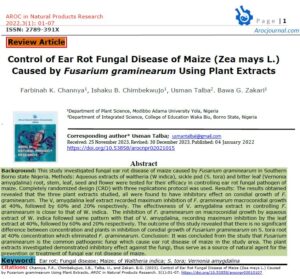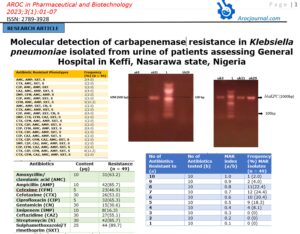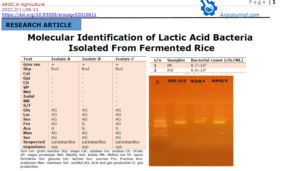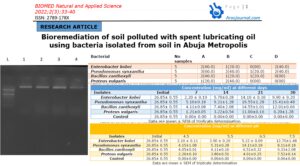- Introduction
Non-timber forest products (NTFPs), along with bamboo, seeds, leaves, rattan, raffia, and other fibres, contribute significantly to the subsistence and welfare of people all over the world, particularly in developing-world rural economies [1,2]. It was claimed that millions of people, primarily those living in rural areas of developing countries, gather these products on a daily basis, and that many see promoting NTFPs as a way to make a living [3] “Eighty percent of the developing world relies on non-timber forest products for nutritional and health needs” [4]. Forests have long been valued for the numerous products and benefits they provide (for example, food, fodder, medicine, fuel wood, timber, and so on), as well as as a source of income from harvesting, processing, and buying and selling in these items [5]. Millions of households in developing countries, primarily Nigeria, rely on non-timber forest products (NTFPs), which have always been an important part of the forest economy [6]. Non-timber forest products have been used for as long as humans have existed [7]. The role and contributions of NTFPs in the daily lives and welfare of people all over the world are essential in subsistence and rural economies because of their variety, as resources of meals which include fruits, nuts, honey, insects, animals, etc. fodder, fibre, fertilisers, medicinal extracts, construction materials, cosmetic and cultural products, natural dyes, tannin, gums, resins, latex and other exudates, essential oils, spices, edible oils, and decorative.
NTFPs have a wide range of applications in Nigerian rural communities. Among these uses were fruits, nuts, honey, insects, and animals. NTFPs are also used as fodders, fibres, fertilisers, medicinal extracts, construction materials, cosmetics and cultural products, natural dyes, tannin, gums, and other exudates. Other benefits include essential oils, spices, edible oils, decorative articles, horns, tusks, bones, pelts, plumes, hides and skins, on-wood ligno-cellulosic products (brown coal with a woody texture), phytochemicals, and aroma chemicals. These products are derived from a variety of sources, including plants (palms, grasses, herbs, shrubs, and trees), animals (insects, birds, reptiles, and large animals), and other non-living ecosystem components. In Nigeria, the supply (production), marketing, and processing of timber were prioritised, with little or no consideration given to non-timber forest products. An enabling framework for NTFP processing includes common market and value chain characteristics. Market Characteristics Easy access to markets, both spatially and temporally, contributes to business success. This can be aided by the presence of NGOs and development projects; however, such initiatives will only be viable if there is sufficient demand for the product.[9] High demand is required for the establishment of NTFP businesses, as evidenced by the high demand for charcoal, brooms, amarula products, and agar oil. Demand is frequently created through intensive marketing efforts, particularly for new products entering international markets [9], funds for which are not always readily available. Nonetheless, studies have shown that the demand potential for NTFP products is substantial, with quality and environmental friendliness being the most important attributes [10]. Projects focusing on NTFP business development without considering demand may fail because the increased supply of products cannot be absorbed, resulting in low product prices. Further constraints persist as a result of frequently fluctuating NTFP markets and price oscillations, boom-bust cycles, or the presence of only one or a few buyers. Under such conditions, it may be too risky for small-scale producers to professionalize their NTFP businesses and forego other income-generating opportunities [5]. However, in recent years, attention has shifted to non-timber forest products due to the enormous benefits they provide for human advancement. The study concentrated on the marketing of non-timber forest products in the Oja-Oba market of the Iseyin Local Government Area. Oyo State The intended respondents are non-timber forest product sellers in the Oja-Oba market.
2.0 Materials and Method
2.1 Area of Research
Iseyin local goveSrnment area is one of the local Governments that make up Oyo State Oke-Ogun location. The local authorities is located at 7″ 58′ 0″ N and 3″ 36 0″ E. Iseyin townships are about a hundred kilometers north of lbadan. The neighborhood government is bounded within the west with the aid of lbarapa North and Kajola local government regions, within the east by Oyo Nest nearby government vicinity, in the north via Itesiwaju local authorities region of the country, and inside the south via lbarapa East nearby government vicinity of Oyo state. The neighborhood government has a tropical weather. There is less rainfall inside the dry season than inside the wet season. The Koppen Geiger Climatic category considers this climate to be. The common annual temperature is 26.1oC. The yearly average rainfall is 1171 mm. January has the fewest rainfalls. This month’s average rainfall totals 7mm. The maximum precipitation falls in September, with an average of 195 mm. In March, the common temperature is around 28.20 ranges Celsius. The common temperature in August is 24.00 tiers Celsius. it is the coldest common temperature of the 12 months. The distinction in precipitation among the driest and wettest months is 188 mm. Temperatures vary by 4.20 degree Celsius on common at some stage in the year. Rivers consisting of the Ogun, Owu, Amaka, and Oowe drain the local Government Area. The vegetation type is guinea Savanna, that’s outstanding through tall and luxuriant grasses and timber which includes acacia, locust bean trees, Shea butter trees, and so on. Figure 1 below showed the study area and the local government area(iseyin Local Government) where the study area was located.

2.2 Data source
For this study primary data were used. Well-structured questionnaires was used used to collect primary data. The data collected covered Statistics for socioeconomic characteristics of individuals involved within the accumulating, processing, and advertising and marketing of NTFPs, which includes age, gender, instructional degree, household size, marital status, income degree, off farm activities, expenses, and so on
2.3 Sampling procedure and sample size
The samples were drawn from the market’s total population of sellers. The average number of marketers in the study area was 376. However, 94 respondents were chosen (about 25 percent sampling intensity). In other words, 94 structured questionnaires were distributed, and 78 (83.0 percent) of them were returned.
2.4 Statistical method
Statistics tools such as frequencies, mean, modes and percentages were used to analyze the variables of interest such as age, gender, family size, education, income, religion, Budgetary analysis was used to analyze profitability.
3.0 Results and Discussion
In this study, 78 (83.0%) of the 94 questionnaires administered had been retrieved and analyzed Table 1 shows the descriptive analysis of the respondents’ socioeconomic traits. According to the table, the majority of respondents (51.4%) were between the ages of 31-40 years, while the least (5.1%) had been between the ages of 51 and above years. This become consistent with the findings of [13], who said that the enormously productive age group involved in forestry activities is 31-50 years. It was found out that 51.3% of respondents were female, even as 48.7% have been male Indicating that extra women were involved the marketing of non-timber forest products (NTFPS).The table additionally found out that 73. 1% of respondents were married, while 2.6% have been widowed. This supported the findings of [11], who said that a massive percentage of the rural populace is married. The effects additionally discovered that the general public of respondents (34.6%) had adult training, followed by people with no formal schooling (24.4%) and those with tertiary schooling (6.4%). This finding commonly indicated that majority of respondents had a low instructional reputation. This supported the findings of [11], who said that formal education is not a chief criterion required for dependent groups to preserve their livelihood. The table also found out that farmers made up most people of respondents (60.3%), at the same time as civil servants made up the least (11.6%). Years of experience within the NTFPs enterprise revealed that respondents with 11-20 years’ experience had the highest rate of forty44.9%, even as only a few (1.3%) had more than 21 years’ experience. Majority of respondents (69.2%) had been indigenous to the vicinity, while 30.8%had not been.
Table 1: Socio-economic characteristics of the respondents
| Socio-economic characteristics | Frequency | Percentage |
| Age | ||
| 20-30 | 7 | 9.0 |
| 31-40 | 40 | 51.3 |
| 41-50 | 27 | 34.6 |
| 50 Above | 4 | 5.1 |
| Total | 78 | 100 |
| Sex | ||
| Male | 38 | 48.7 |
| Female | 40 | 51.3 |
| Total | 78 | 100 |
| Marital status | ||
| Single | 9 | 11.5 |
| Married | 57 | 73.1 |
| Divorce | 10 | 12.8 |
| Widow | 2 | 2.6 |
| Total | 78 | 100 |
| Educational status | ||
| No Formal | 19 | 24.4 |
| Adult | 27 | 34.6 |
| Primary | 9 | 11.5 |
| Secondary | 18 | 23.1 |
| Tertiary | 5 | 6.4 |
| Total | 78 | 100 |
| Occupation | ||
| Trader | 22 | 28.2 |
| Farmer | 47 | 60.3 |
| Civil Servant | 9 | 11.6 |
| Total | 78 | 100 |
| Years of experience | ||
| 0-5 | 8 | 10.3 |
| 6-10 | 32 | 41.0 |
| 11-20 | 35 | 44.9 |
| 16-20 | 2 | 2.6 |
| 21 Above | 1 | 1.3 |
| Total | 78 | 100 |
| Nativity | ||
| Indigene | 54 | 69.2 |
| Non- Indigene | 24 | 30.8 |
| Total | 78 | 100 |
Source: Field survey, 2021
The NTFPs marketed in the location have been proven in table 2. It became located that numerous NTFPs in the observe location include honey and bees wax, fit to be eaten plant products including black pepper, gums and resin exuding, bush meat, canes for making baskets, wrapping leaves, fuel wood, and charcoal, among others. Moreover, bush meat (73.1%) honey and bee wax (71.8%). fuel Wood and charcoal (60.3%), shea butter (60.3%), sponge (57.7%), palm wine (56.4%), and canes (56.4%) were the most plentiful NTFPs inside the study area. According to the observe, the area is relatively enriched with numerous sorts of NTFPs that serve the desires of the inhabitants. This was consistent with the findings of [11], who said that NTFPs are any biological assets collected from the wild via rural human beings for direct intake and profits generation.
Table 2: NTFPs in the study area
| S/No | Available NTPFs | Yes (Fq) | Yes (%) | No (Fq) | No (%) |
| 1 | Honey and bees wax | 56 | 71.8 | 22 | 28.2 |
| 2 | Edible plant products | 34 | 43.6 | 44 | 56.5 |
| 3 | Gums and resin exuding | 44 | 56.4 | 34 | 43.6 |
| 4 | Bamboo | 34 | 43.6 | 44 | 56.4 |
| 5 | Fuel wood and charcoal | 47 | 60.3 | 31 | 39.7 |
| 6 | Fodder and forage | 39 | 50.0 | 39 | 50.0 |
| 7 | Mushroom | 42 | 53.8 | 36 | 46.2 |
| 8 | Calabash | 43 | 55.1 | 35 | 44.9 |
| 9 | Sponge | 45 | 57.7 | 33 | 42.3 |
| 10 | Broom | 43 | 55.1 | 35 | 44.9 |
| 11 | Bush meat | 57 | 73.1 | 21 | 26.9 |
| 12 | Nuts | 26 | 33.3 | 52 | 66.7 |
| 13 | Shea butter | 47 | 60.3 | 31 | 39.7 |
| 14 | Wrapping leaves | 43 | 55.1 | 35 | 44.9 |
| 15 | Palm wine | 44 | 56.4 | 34 | 43.6 |
| 16 | Ropes | 38 | 48.7 | 40 | 51.3 |
| 17 | Medicinal plants | 44 | 56.4 | 34 | 43.6 |
| 18 | Shells and bone | 36 | 46.2 | 42 | 53.8 |
| 19 | Canes for making basket | 44 | 56.4 | 34 | 43.6 |
| 20 | Hides, skins and feathers | 40 | 51.3 | 38 | 48.7 |
| 21 | Dye and colour yielding plants | 42 | 53.8 | 36 | 46.2 |
Source: Field survey, 2021
Table 3: Prices of NTFPs at different levels
| NTFPs | Qty | Farm Price(₦) | Market Price(₦) | Selling Price(₦) | |
| Honey and bees wax | 5 litres | 5000 | 6000 | 7500 | |
| Edible plant products | 5kg | 400 | 500 | 550 | |
| Gums and resin exuding | 1kg | 900 | 1000 | 1500 | |
| Bamboo | 5kg | 500 | 600 | 750 | |
| Fuel wood; charcoal | 10kg | 600 | 650 | 700 | |
| Fodder and forage | 10kg | 400 | 450 | 500 | |
| Mushroom | 50kg | 400 | 450 | 600 | |
| Calabash | 1dozen | 300 | 400 | 550 | |
| Sponge | 6 pack | 400 | 450 | 500 | |
| Broom | 1dozen | 500 | 600 | 700 | |
| Bush meat | 5kg | 2500 | 3500 | 6000 | |
| Nuts | 1 congo | 800 | 1000 | 1100 | |
| Shea butter | 5 kg | 600 | 700 | 800 | |
| Wrapping leaves | 2kg | 200 | 400 | 450 | |
| Palm wine | 25 litres | 2000 | 2200 | 2400 | |
| Ropes | 1 bundle | 450 | 470 | 510 | |
| Medicinal plants | 2kg | 300 | 350 | 400 | |
| Shells and bone | 10kg | 700 | 750 | 900 | |
| Canes | 2kg | 250 | 300 | 450 | |
| Hides, skins and feathers | 5kg | 500 | 600 | 700 | |
| Dye | 2 litres | 250 | 300 | 400 |
Source: Field survey, 2021
Table 3 displayed the prices of NTFPS marketed and their charges at various levels. The products had specific fee tags, and these varies from the farm level to the very last retail selling price, for instance, honey which sells at #6000.00/ 5litres farm price is finally bought at #7500.00 to the very last consumers, while products including bush meat and palm wine which sell at# 2500.00 and #2000.00 are offered at# 6000.00 and# 2400.00 respectively. This shows that the marketing of NTFPs is a worthwhile commercial enterprise in the study region. This was consistent with the findings of [12,13] that NTFPs are any biological resources collected from the wild by rural human beings for direct intake and income generation
Profitability of the most heavily marketed NTFPs in the study area
Consistent with the responses of the respondents, the best marketed NTFPs have been bush-meat and honey (73. 1% and 71.8%, respectively). As a result, the profitability of these NTFPs changed into calculated and proven in tables 4 and 5.
Table 4 depicted the profitability of bush meat in the study location. Following the computation, it became observed that the marketing of bush meat became extremely worthwhile. The average gross margin received became #34,040.00, indicating that marketing efficiency became on a fine note, and the effectiveness established the earnings in line with price incurred at some point of the enterprise transaction, as determined through estimating the benefit cost ratio (BCR), which found out to be 2.53. As a result, for every# 2.00 invested by respondents, a return of 53kobo was received. This supported the findings of [12,14,15], when they stated that non-timber forest products function a mechanism for poverty alleviation and local development.
Table 4: Profitability of Bush meat in the study area
| Items | Cost (₦) |
| Variable cost | |
| Price per 20kg | 10000.00 |
| Transport cost | 800.00 |
| Labour | 1500.00 |
| Total variable cost | 12,300.00 |
| Fixed cost | |
| Depreciation on Cutlass | 1200.00 |
| Depreciation on Basket | 1000.00 |
| Depreciation on Sack bag | 500.00 |
| Depreciation on Tray | 800.00 |
| Depreciation on table | 2500.00 |
| Total fixed cost | 6,000.00 |
| Total cost (TVC + TFC) | 18,300.00 |
| Total income | 46, 340.00 |
| Net profit | 28,040.00 |
| Gross margin (GM) (TC- TVC) | 34,040.00 |
| Benefit cost ratio (BCR) | 2.53 |
Source: Field Survey 2021
Table 5 depicted the profitability of honey and bee wax within the area of study. It became determined that the advertising and marketing of honey and bee wax become also extremely worthwhile. The average gross margin obtained became #30,380.00, indicating that marketing efficiency was on a high-quality Word, and the effectiveness verified the earnings in keeping with value incurred in the course of the business transaction, which become calculated through estimating the benefit cost ratio (BCR), which revealed 1.69 an end result, for each# 1.00 invested via respondents, they received a return of sixty-nine kobo. This supported the findings of [15,16], who stated that non-wood forest products serve as a mechanism for poverty alleviation and local development.
Table 5: Profitability of honey and bee wax in the study area
| Items | Cost (₦) |
| Variable cost | |
| Price per 25litres | 25,000.00 |
| Transport cost | 600.00 |
| Labour | 500.00 |
| Total variable cost | 26,100.00 |
| Fixed cost | |
| Depreciation on jerry cans | 1000.00 |
| Depreciation on plastic bottles | 3000.00 |
| Depreciation on plastic bowls | 800.00 |
| Depreciation on table | 2500.00 |
| Total fixed cost | 7,300.00 |
| Total cost (TVC + TFC) | 33,400.00 |
| Total income | 56,480.00 |
| Net profit | 23,080.00 |
| Gross margin (GM) (TI- TVC) | 30,380.00 |
| Benefit cost ratio (BCR) | 1.69 |
Source: Field Survey 2021
Marketing issues with NTFPs in the study area
Table 6 depicts the current issues associated with the marketing of NTFPs in the study area. Poor transportation was identified as the most significant problem in NTFPs marketing, accounting for 35.9% of the total; this was followed by a lack of storage space, accounting for 23.1%. Having no buyer to patronize the sellers of the products, on the other hand, recorded the lowest rate of 3.8%. This could be because most of the roads leading to forest areas are in poor condition. As a result, a poor transportation network leads to high costs in transporting products from the point of purchase to the destination of sales. This supported the findings of [11,17] who identified poor transportation as one of the major challenges of marketing NTFPs in Southwest Nigeria.
Table 6: Marketing problems of NTFPs in the study area
| Problems | Frequency | Percentage |
| Poor transportation | 28 | 35.9 |
| Lack of storage facility | 18 | 23.1 |
| Seasonality | 6 | 7.7 |
| Price fluctuation | 9 | 11.5 |
| No buyer | 3 | 3.8 |
| Deforestation | 10 | 12.8 |
| Poor market outlet | 4 | 5.2 |
| Total | 78 | 100 |
Source: Field Survey 2021
4.0 Conclusion
Based on the findings of this study, it was determined that the area was highly enriched with various varieties of NTFPs that serve the needs of the residents. Among these NTFPs are honey and bees wax, edible plant products such as black pepper, gums and resin exuding, bush meat, canes for making baskets, wrapping leaves, fuel wood, and charcoal.
The following recommendations were made based on the findings of this study: Sustainable Forest management of non-timber forest products should be implemented as a development strategy in the study area to ensure the continuous availability of non-timber forest products in the study area.
Awareness programs about the availability and importance of non-timber forest products should be organized for rural residents in and around the study area. Furthermore, orientation programs should be organized to educate forest-dependent communities about the business of non-timber forest products as a source of employment. Non-timber forest products can provide an additional source of income for those who earn a living. Road reconstruction and the installation of storage facilities should be provided to encourage non-timber forest products business in and around the study area
Acknowledgement: The authors acknowledge Federal College of Forestry for providing enabling environment for this research to be able to carry it out.
Conflict of Interest: The author declared that no conflict of interest exists
Ethical Approval: Not applicable
Consent: Not applicable
Reference
- Mahaptara, A. and Mitchell, C.P. (2011): Non-timber Forest Products Management Problems and Prospects: A case study from India. Retrieved on 8th June 2011 from http://www.w3c.org/TR/1999/REC-html401-19991224/loose.dtd
- Andel, T.V. (2006): Non-timber forest products: The value of Wild Plants. Agromisa Publication 6 CTA, the Netherlands.
- Agbogidi, A.O. (2010): Ethno-botanical survey of the Non-timber forest products in Sapele Local Government Area of Delta State, Nigeria. African Journal of Plant Science. Vol. 4(3), pp. 183 189 Retrieved on 8th June, 2011 from http://www.academicjournals.org/ajps
- FAO, (2003): Management of non-timber forest products extraction: local institutions, ecological knowledge and market structure in south-eastern Zimbabwe. Ecological economics 70 (3), 454-461.
- Tewari, D.D. (2012): Promoting non-timber forest products (NTFPs) to alleviate poverty and hunger in rural South Africa: A reflection on management and policy challenges. African Journal of Business Management Vol. 6(47), pp.11635 11647, 28. http://www.academicjournals.org/AJBM DOI: 10.5897/AJBM12.583s.
- Neumann, R.P.; Hirsch, E. (2000): Commercialisation of Non-Timber Forest Products. Review and Analysis of Research; CIFOR: Bogor, Indonesia.
- Aiyeloja, A.A. and Ajewole, O.I. (2006): Non-timber Forest Products’ Marketing in Nigeria: A case study of Osun State. Educational Research and Reviews. Vol.1 (2), pp. 52-58.
- Krause, T.; Ness, B (2017): Energizing agroforestry: Ilex guayusa as an additional commodity to diversify Amazonian Agroforestry systems. Int. J. Biodivers. Sci. Ecosyst. Serv. Manag. 13, 191–203
- Seeland, K.; Kilchling, P.; Hansmann, R. (2007): Urban Consumers’ Attitudes towards Non-wood Forest Products and Services in Switzerland and an Assessment of Their Market Potential. Small-Scale For. Econ. Manag. Policy 6, 443–452
- Olawuyi E.B. and Agbeja B.O. (2018). Socio-economic impact of gazetted forest reserves on forest dependent communities in Edo State, Nigeria. Commonwealth Forestry Association (CFA) Conf. Proc., 2, 51-60
- Babatunde T.O., Babatunde O.O, Adekola P.J, Ojo M.O and Shittu A.J. (2013) Marketing of some selected non-timber forest products in Boluwaduro Local Government area of Osun State. Journal of Qualitative education. 9(2), ISSN 0331-4790 pgs 167-177.
- Babatunde T.O, Babatunde O.O. Okeleke S.O, Aduloju T. and Agboola F.O. (2020) Assessment of commercial importance and determinant factor influencing collection of non-timber forest products in adjoining communities of Lanlate forest reserve of Oyo State Nigeria Journal of Research in Forestry, Wildlife & Environment Vol 12 (1). Pp 62-69 University of Agriculture, Markudi
- Babatunde T.O, Babatunde O.O, Oluwalana T. and Agboola F.O and Okeleke S.O. (2019) Evaluation on non-timber forest product collection in Arakanga Forest reserve in Ogun State Nigeria. Nigeria Journal of Agricultural and Development Economies (NIJADE) University Of Abuja Vol 5 (2) pp 123-136
- Olawuyi E.B., Adejumo A.A. and Faleyimu O.I. (2019): Socio-economic impact of non-timber forest products in rural household income in Osho forest reserve, Oyo state, Nigeria. Agric. Sci. Res. J., 9 (3), 27-348
- Babatunde T.O, Babatunde O.O., Okeleke S.O.,Oluwalana T.,Ogundimu O.A. and Elesho R.O. 2019. Contributions of Non-Timber Forest Products to Household Income in the Adjoining Communities of the Lanlate Forest Reserve of Oyo State, Nigeria. FUOYE Journal of Agriculture and Human Ecology. Vol 3(1) pp 47-555.
- Babalola J.B;. Adesoji Oni;. Ademola Atanda; Benedicta O; Oyejola- Oshodi. (2010): Poverty alleviation in Nigeria: lesion from socio-economic thoughts of Yoruba. http://doi.org.111/j.1468-2451.20
- Tewari, D.D. (2012): Promoting non-timber forest products (NTFPs) to alleviate poverty and hunger in rural South Africa: A reflection on management and policy challenges. African Journal of Business Management Vol. 6(47), pp.11635 11647, 28. http://www.academicjournals.org/AJBM DOI: 10.5897/AJBM12.583s.







